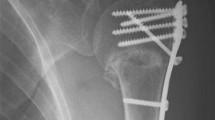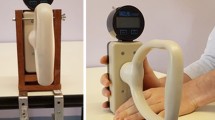Abstract
Muscle disability is a common sequel after fracture management. Previous research has shown divergent results concerning muscle-power recovery after bone healing. This study has investigated the muscle function of wrist extensors after lateral condylar fracture in children, as evaluated by a hand-held dynamometer and compared with sex- and age-matched children. From 1999 to 2004, 20 patients (13 boys and seven girls; mean age: 9 years and 4 months) with displaced lateral condylar fracture of the humerus were treated by open reduction and internal fixation with Kirschner wires (K-wire). The duration of K-wire fixation was 35 days and the mean follow-up time was 50 months. A total of 180 healthy age-, sex- and weight-matched children were used as control groups. A paired Student’s test was applied for the analysis of statistical significance. The range of motion of the elbow and radiographic findings were not significantly different between the injured limb and normal control groups. The maximum isometric power of wrist-extensor muscles after surgical treatment of lateral condylar fracture of the humerus in final follow-up was not statistically different from that in the normal control children. Muscle power therefore recovers to its normal status after the healing of lateral condylar fracture of the humerus in children.
Résumé
Les troubles fonctionnels musculaires sont une séquelle relativement fréquente après le traitement d’une fracture. Les résultats des recherches faites de façon à évaluer la fonction musculaire, montrent, une fois l’os guéri, des résultats divergents. Cette étude de la fonction musculaire a été réalisée au niveau des extenseurs du poignet après fracture du condyle externe du coude, en utilisant un dynamomètre et en comparant les résultats en fonction du sexe et de l’âge. De 1999 à 2004, 20 patients (13 garçons, 7 filles; l’âge moyen: 9 ans et 4 mois) ont présenté une fracture déplacée du condyle externe de l’humérus traitée par réduction sanglante et brochage. Le temps de fixation par broche a été de 35 jours et le suivi moyen a été de 50 mois. Une analyse comparative de 180 critères a été réalisée. Il n’y a pas eu de différences significatives en ce qui concerne le résultat sur la fonction du coude, la mobilité et la consolidation. De même, il n’y pas eu de différences significatives en ce qui concerne la tension isométrique des extenseurs du poignet comparés au membre contro latéral, comparé sur une série d’enfants contrôle. On peut en conclure que le muscle retrouve une fonction complète après guérison d’une fracture déplacée du condyle externe chez l’enfant.


Similar content being viewed by others
References
Andrews AW, Thomas MW, Bohannon RW (1996) Normative values for isometric muscle force measurements obtained with hand-held dynamometers. Phys Ther 76:248–259
Backman E, Odenrick P, Henriksson KG, Ledin T (1989) Isometric muscle force and anthropometric values in normal children aged between 3.5 and 15 years. Scand J Rehabil Med 21:105–114
Badelon O, Bensahel H, Mazda K, Vie P (1988) Lateral humeral condylar fractures in children: a report of 47 cases. J Pediatr Orthop 8:31–34
Bialocerkowski A, Grimmer KA (2003) Measurement of isometric wrist muscle strength—a systematic review of starting position and test protocol. Clin Rehabil 17:693–702
Boone DC, Azen SP, Lin CM, Spence C, Baron C, Lee L (1978) Reliability of goniometric measurements. Phys Ther 58:1355–1360
Bowman OJ, Katz B (1984) Hand strength and prone extension in right-dominant, 6 to 9 years olds. Am J Occup Ther 38:367–376
Burns SP, Spanier DE (2005) Break-technique handheld dynamometry: relation between angular velocity and strength measurements. Arch Phys Med Rehabil 86:1420–1426
Docherty CL, Moore JH, Arnold BL (1998) Effects of strength training on strength development and joint position sense in functionally unstable ankles. J Athl Train 33:310–314
Gaston P, Will E, McQueen MM, Elton RA, Court-Brown CM (2000) Analysis of muscle function in the lower limb after fracture of the diaphysis of the tibia in adults. J Bone Joint Surg 82B:326–331
Gregory TC (1997) Rehabilitation management in neuromuscular disease. J Neuro Phys Rehab 11:69–80
Hedin H, Larsson S (2003) Muscle strength in children treated for displaced femoral fractures by external fixation: 31 patients compared with 31 matched controls. Acta Orthop Scand 74:305–311
Henderson RC, Kemp GJ, Campion ER (1992) Residual bone-mineral density and muscle strength after fractures of the tibia or femur in children. J Bone Joint Surg 74A:211–218
Hennrikus WL, Kasser JR, Rand F, Millis MB, Richards KM (1993) The function of the quadriceps muscle after a fracture of the femur in patients who are less than seventeen years old. J Bone Joint Surg 75A:508–513
Jakob R, Fowles JV, Rang M, Jassab MT (1975) Observations concerning fractures of the lateral humeral condyles in children. J Bone Joint Surg 57B:430–436
Kilmer DD, Abresch RT, Fowler WM Jr (1993) Serial manual muscle testing in Duchenne muscular dystrophy. Arch Phys Med Rehabil 74:1168–1171
McKee MD, Wilson TL, Winston L, Schemitsch EH, Richards RR (2000) Functional outcome following surgical treatment of intra-articular distal humeral fractures through a posterior approach. J Bone Joint Surg 82A:1701–1707
Milch H (1964) Fractures and fracture-dislocations of humeral condyles. J Trauma 4:592–607
Paula TK, Damien WA, Terry LG, Shane LK, Stephen CA, Jean MB, et al (1999) Effect of the forearm support band on wrist extensor muscle fatigue. J Orthop Sports Phys Ther 29:677–685
Stamatis E, Paxinos O (2003) The treatment and functional outcome of type IV coronal shear fractures of the distal humerus: a retrospective review of five cases. J Orthop Trauma 17:279–284
Van Vugt AB, Severijnen RV, Festen C (1988) Fractures of the lateral humeral condyle in children: late results. Arch Orthop Trauma Surg 107:206–209
Zacharova G, Knotkova-Urbancova H, Hnik P, Soukup T (1997) Nociceptive atrophy of the rat soleus muscle induced by bone fracture: a morphometric study. J Appl Physiol 82:552–557
Author information
Authors and Affiliations
Corresponding author
Rights and permissions
About this article
Cite this article
Chou, PH., Feng, CK., Chiu, FY. et al. Isometric measurement of wrist-extensor power following surgical treatment of displaced lateral condylar fracture of the humerus in children. International Orthopaedics (SICO 32, 679–684 (2008). https://doi.org/10.1007/s00264-007-0380-3
Received:
Revised:
Accepted:
Published:
Issue Date:
DOI: https://doi.org/10.1007/s00264-007-0380-3




